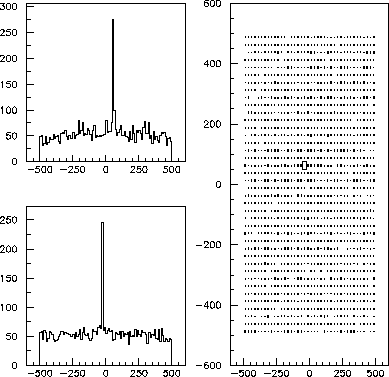Pairing consists in associating the same objects of two catalogues, so as to determine the geometrical transformation which connects them. This transformation will be then used for reéchantilloner one of the two images on the grid of the other.
Pairing must initially seek a transformation which brings the catalogues in coincidence coarsely, and then refine this transformation. We seek initially if a simple translation to bring the catalogues in coincidence by histogrammant the differences of the co-ordinates of each object of a catalogue to all the objects of the other. One can see a Net maximum on figure 7.13 which indicates the most probable values of translation. If this translation does not make it possible to associate a sufficient fraction of the two catalogues, we seek a more complex transformation then: translation, dilation and rotation. This research is made by a similar method of histograms, but in a space of parameters of dimension 4. To limit combinative exploration, only the most brilliant objects are then considered.
 |
The same algorithm of association of catalogues is used to associate the catalogue of an image an external catalogue, in which the objects are located in sidereal co-ordinates. This association makes it possible to produce a transformation known as WCS (World Coordinate System) which transforms the co-ordinates of each pixel into sidereal co-ordinates. The majority of the systems of frame grabbing provide today an image with a WCS, by using information of pointed telescope, and the orientation of the instrument. When two images to be associated lay out both of a WCS, one can use them to determine the transformation which associates the points of the two images which address the same point of the sky. In the phase of research of the transformation, it is the first test which our code carries out. But no matter what it arrives, the transformation will be adjusted on the co-ordinates of the objects measured in the images, so as to eliminate any uncertainty coming from the use of the external catalogue.